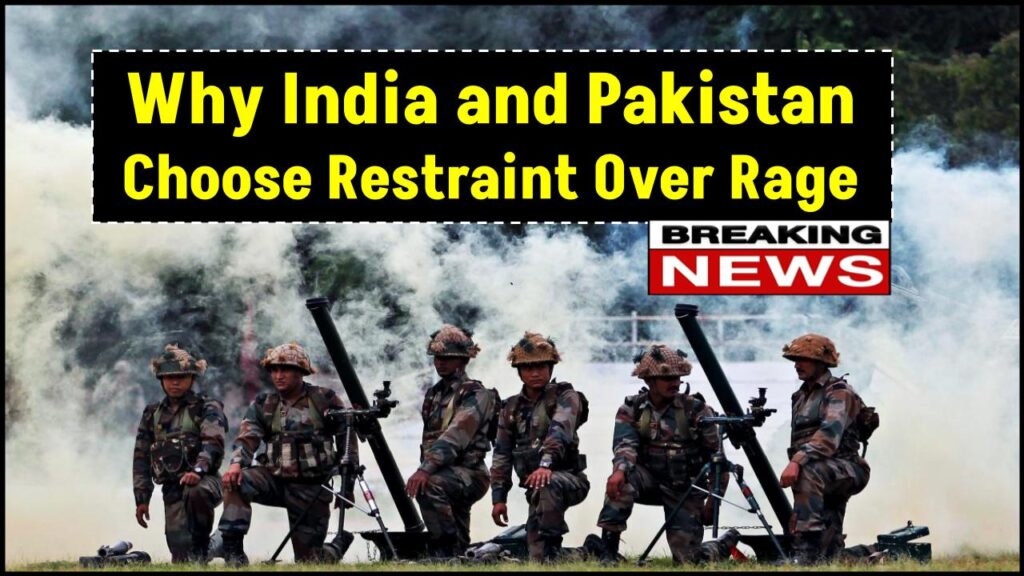Why India and Pakistan Fight With Restraint: India and Pakistan share one of the world’s most enduring and intense rivalries. Despite their frequent clashes, these two nuclear-armed neighbors often exercise remarkable restraint. Unlike many prolonged conflicts that spiral into all-out wars, India and Pakistan have managed to avoid full-scale confrontations since their last major war in 1971. Instead, their exchanges tend to be brief, calculated, and controlled. But why is this the case?
Understanding why India and Pakistan choose caution over chaos involves exploring the complex factors that shape their military and diplomatic decisions. From nuclear deterrence to economic considerations, this article breaks down the reasons behind their measured approach to conflict.

Why India and Pakistan Fight With Restraint
| Factor | Description | Impact on Conflict | Source |
|---|---|---|---|
| Nuclear Deterrence | Both countries possess nuclear weapons, raising the stakes of escalation. | Prevents large-scale wars due to the risk of mutual destruction. | AP News |
| Doctrinal Strategies | India’s “Cold Start” and Pakistan’s tactical nukes emphasize rapid, limited engagements. | Encourages restraint to avoid nuclear thresholds. | Wikipedia |
| International Pressure | Major powers like the U.S. and China often mediate during crises. | Promotes de-escalation to maintain global stability. | Time |
| Economic Constraints | Economic challenges make prolonged conflict costly. | Limits aggressive posturing. | The Times |
| Public Sentiment | Citizens in both countries often favor peace over conflict. | Acts as a moderating force. | Multiple sources |
India and Pakistan’s conflict is a unique example of measured aggression, where both sides engage in controlled skirmishes while carefully avoiding full-scale war. This restraint is driven by nuclear deterrence, economic concerns, public sentiment, and international diplomacy, creating a complex but relatively stable security dynamic.
Why Nuclear Deterrence Dominates the Dynamic
One of the most significant reasons India and Pakistan avoid full-scale war is the catastrophic potential of nuclear conflict. Both nations conducted nuclear tests in 1998, establishing themselves as formidable atomic powers. This nuclear capability acts as a powerful deterrent, as the consequences of miscalculation are too dire for either side to ignore.
The Balance of Fear
The concept of “Mutually Assured Destruction” (MAD) plays a crucial role here. If either country were to launch a nuclear strike, the other could retaliate with equal or greater force, leading to mass destruction on both sides. This grim reality forces both nations to exercise extreme caution, even during periods of heightened tension.
Doctrinal Strategies: Limited War, Maximum Impact
India’s military strategy has evolved to include the “Cold Start” doctrine, which aims for rapid, localized strikes in response to provocations. The idea is to deliver a quick, decisive blow without crossing the nuclear threshold. In response, Pakistan developed tactical nuclear weapons as a deterrent, effectively neutralizing India’s advantage in conventional forces.
Cold Start in Action
For instance, during the 2019 Balakot airstrikes, India conducted a targeted air raid in Pakistan following a terror attack in Kashmir. Pakistan’s response was carefully calibrated, avoiding direct escalation while demonstrating military readiness. This dance of calculated moves reflects a broader strategy where both sides seek to project strength without triggering all-out war.
The Role of International Pressure
Global powers have a vested interest in preventing an India-Pakistan conflict from spiraling out of control. The United States, China, and Gulf states often act as intermediaries, applying diplomatic pressure to de-escalate crises. This external influence can be critical in moments of crisis, encouraging both sides to back down before reaching the point of no return.
Economic Constraints and Public Sentiment
Both countries also face significant economic challenges. For Pakistan, struggling with high inflation and a fragile economy, a prolonged conflict would be disastrous. India, with its ambitions of becoming a global economic powerhouse, also stands to lose significantly from war-induced instability.
Additionally, public sentiment in both countries often leans toward peace. While nationalist fervor can spike during conflicts, prolonged instability can undermine public support for aggressive policies, pushing governments toward de-escalation.
FAQs on Why India and Pakistan Fight With Restraint
1. Why don’t India and Pakistan go to full-scale war despite frequent skirmishes?
The risk of nuclear escalation and economic costs make prolonged conflict undesirable for both nations.
2. What is the “Cold Start” doctrine?
It is India’s military strategy for rapid, localized strikes without triggering nuclear retaliation.
3. How do international players influence India-Pakistan conflicts?
Major powers often intervene diplomatically to prevent escalation and maintain regional stability.





